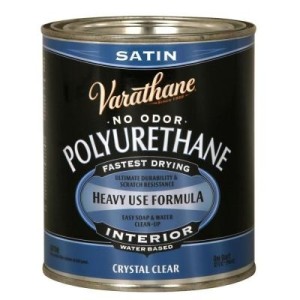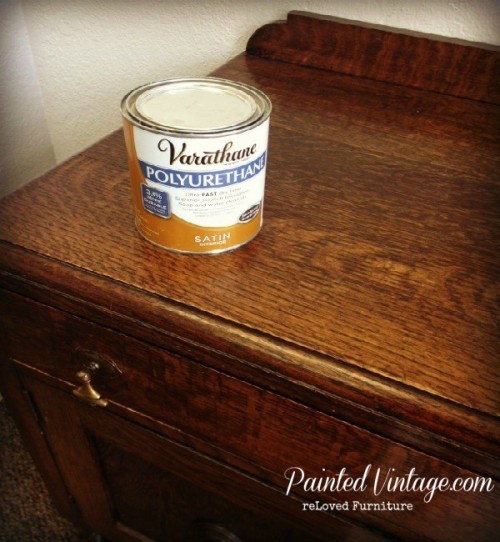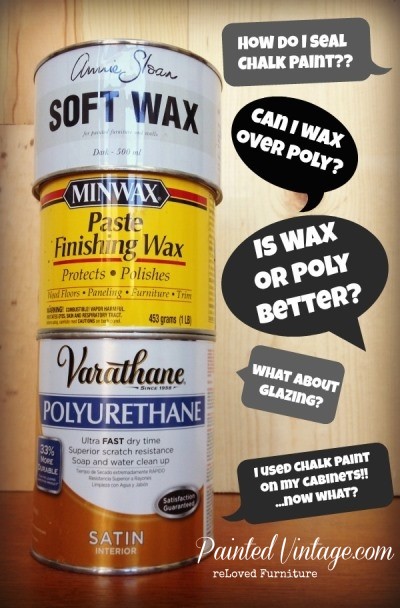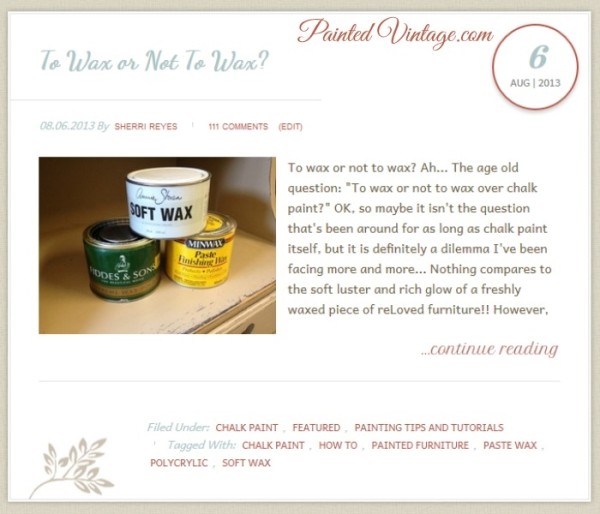Wax or Polycrylic over chalk paint?
All your questions about using wax vs. polycrylic over chalk paint answered!
The response has been overwhelming to my post on using wax or polycrylic over chalk paint (you can read the original post here: To Wax or Not to Wax?)
So, I decided to post an update with answers to your most frequently asked questions on applying a finish over chalk paint and wax alternatives.
Should I use a wax OR polycrylic over chalk paint? The answer really depends on how you will use the piece of furniture and how much time you are willing to invest in maintaining the finish. As I explained in my original post To Wax or Not to Wax? while waxing over chalk paint (or any variation of chalk style paint such as clay paint, mineral paint, and even DIY chalk paint) gives you a gorgeous velvety luster, it is NOT A PERMANENT finish and must be reapplied frequently to maintain the look and the protection of the wax. So if you absolutely must have the waxed finish, be prepared to also bust out a big can of elbow grease every few months!
That’s where water-based polyurethane finishes come in. Known as polycrylics, these finishes are an excellent alternative to use over chalk paint, for several reasons. Mostly they offer more of a permanent, durable finish that does not need to be reapplied. They are not heat sensitive like waxes are and they do not need to be completely removed should you chose to repaint. Oh, and they do not require any special courses in correct application techniques!
So for me personally, polycrylic wins the wax vs. poly challenge, hands down as my go-to finish of choice over chalk painted furniture.
What kind of wax would you use? Honestly, I rarely wax over chalk painted furniture anymore. But occasions do arise when I will use waxes. I love Minwax Paste Finishing Wax. It’s easy to work with and buffs out to a gorgeous finish! Another big plus is that it’s easy to find!! If I am going to be using a dark wax, I like the Annie Sloan Soft Wax.
What type of clear sealer do you use over chalk paint? There are several brands of water based polycrylics available. Admittedly, I have not tried them all, but I have tried several. I really like the Minwax Polycrylic, and I also love ease of the Minwax Wipe-On Poly for small projects. But, my all-time favorite is Varathane Crystal Clear Water-Based Polyurethane.
 Varathane Crystal Clear Poly goes on a little milky, but dries clear and stays clear! I have NEVER had any issues with Varathane Crystal Clear yellowing, as some polycrylics can over white painted furniture. This is my go-to product when applying a polyurethane over WHITE chalk paint. It is getting harder to find this product. But depending on which state you live in, you can still order online from HomeDepot.com
Varathane Crystal Clear Poly goes on a little milky, but dries clear and stays clear! I have NEVER had any issues with Varathane Crystal Clear yellowing, as some polycrylics can over white painted furniture. This is my go-to product when applying a polyurethane over WHITE chalk paint. It is getting harder to find this product. But depending on which state you live in, you can still order online from HomeDepot.com
In my area, the Crystal Clear formula has been replaced with a white labeled can that just reads: Varethane Polyurethane. I have been using this product for several months, and so far **knocking this wood buffet** I seem to have the same results as the Crystal Clear formula. UPDATE 9/15/14: I contacted Rustoleum and have been told the white label can is NOT the beloved Crystal Clear Formula. So , while I have not experienced any yellowing, I just want to clarify, THIS IS NOT IS CRYSTAL CLEAR FORMULA.

I should point out that POLYCRYLIC generally refers to a water-based finish, and POLYURETHANE refers to an oil-based finish. Varathane calls both their water-based and oil-based formulas by the generic “Polyurethane” name. In this post, I am specifically referring to the water-based formula only. Oil-based polyurethanes WILL AMBER over time.
How do you apply the poly over chalk paint? Using a good quality synthetic brush (Purdy’s are my preference) apply the poly in the direction of the natural wood grain. Using long, even strokes, work in one direction only, and try not to “over work” it by going back and forth into the wet area. Allow it to dry a couple hours between coats. While it does not require sanding between coats, I will sometimes sand lightly with a brown paper bag (yes, the grocery / lunch sack kind) if I need to knock down any bumps or little ridges. This can also be done after to buff it out to a gorgeous shine.
I have already waxed over my chalk paint, can I just apply poly over the wax? No. If you have used wax, it must be completely removed prior to applying anything. You cannot apply polycrylic over a waxed surface. You see, as the wax dries it becomes a natural water repellant. WAX REPELS WATER. That’s what wax does. Therefore, the poly has nothing to adhere to, because the wax is busy doing its job of repelling… An easy rule of thumb to remember IF your are going to use wax: “WAX IS LAST”
“Wax is Last”
Now, I have read that Annie Sloan wax can be top-coated with a polycrylic. Besides ASCP, I have also heard other chalk style paint manufactures claiming that you can apply poly over wax. I personally will never recommend that, and neither do the polycrylic manufactures. The back of my can reads “surface must be free from wax before applying” in two different areas of the label.
What about painting over wax? Same concept as above applies. If you would like to repaint furniture that has already been chalk painted and waxed, you must remove the wax first. Paint will not adhere directly to the wax. Wax can be removed by wiping the surface down with mineral spirits. Once the wax has been removed, you can proceed with your project. (Now I personally, would still prime with Zinsser Cover Stain, but I’m old school that way.)
Again, I have heard Annie Sloan Chalk Paint and a few other chalk-style manufactures say you can apply chalk paint, clay paint, or mineral paint directly over wax. I personally, would never suggest this. My preferred method for painting over wax, is to remove the wax FIRST. (…annnnd I’d probably prime)
Can I apply wax over polycrylic? Yes, you can. If you want the durability of the poly, but the look of a wax, you can use them together AS LONG AS THE WAX IS THE FINAL COAT. Because of the nature of wax and the way it cures, I would suggest using a matte poly if you want a wax top coat. Allow it to dry completely before waxing.
Can I apply Dark Wax over poly? Yes. Remember the rule “Wax is Last” So if dark wax is going to be your last step, you can absolutely apply it over poly. If you have just painted furniture with chalk paint and you want to really bring out the details and give your piece some character, dark wax is a wonderful product. Apply the poly first, so the dark wax does not stain the porous chalk paint.
Can I glaze over the poly? Yes, you can. If you want to add a dark glaze over chalk paint, apply a light coat of poly so the glaze does not stain the porous chalk paint. You can then glaze on top, once the poly is dried. You’ll want to apply another coat or two of the poly after you’ve waited patiently for the glaze to completely dry- don’t rush the waiting part here… it’s important. Otherwise you’ll make a mess- just trust me…
Can I use Chalk Paint over the polycrylic? Yes, you can. That is one of the benefits of using a polycrylic vs wax. If you change your mind on the color, or simply want to repaint your furniture piece later on down the road, you can do that! The poly does not need to be removed.
What kind of sealer do you recommend for Chalk Painted kitchen cabinets? A polycrylic would be my preference. I would not use a wax for a few reasons. If you’re like me, your cabinets will need to be wiped down almost daily. Splashes, spills and tons of chocolatey little fingerprints may need to be scrubbed. Lots of heat from all the cooking and baking that may (or may not) be going on… Wax will wear down very quickly under those conditions and will need to be re-applied more frequently. Let’s face it, waxing kitchen cabinets is not high on my monthly to-do list of chores. If I am going to spend the time to redo kitchen cabinets, I only want to do it once, and forget it! I really don’t need frequent reminders of what hard work that can be!
What kind of sealer can I use on my kitchen table top? For the same reasons listed above, I would use a polycrylic. At least 4-6 coats would provide a gorgeous, durable finish that would hold up well under the use and abuse a kitchen / dining table may receive. If I really wanted a virtually indestructible finish, I’d go with the Varathane Floor Finish.
Disclaimer: Although I think I would be a heck of a great spokesperson… (are you listening @rustoleum??) I am not sponsored or compensated in any way by Varathane. I just love the brand and have used it for dozens of years, even back when it was called Diamond by Flecto.
I hope you will find my answers to these frequently asked questions helpful in your research about using wax or polycrylic over chalk paint. These are actual questions I have been asked by my readers, and the answers given are what I would do in a given situation, based on my personal experiences. If you’d like to read my original post, you can find it here:







I’m painting my kitchen cabinets in Annie Sloan french linen. (Grayish green) what poly do you recommend? Will the matte be too flat looking and how long after I paint should I apply the polyurethane? How many coats? Thanks so much, lisa
Hi! So I’m using the poly over white American decoart and it’s bubbling. Do you know why or how to stop this? Thanks so much!
Quick question about using the polyurethane over the chalk paint, do you distress it before or after you put the polyurethane. I used a dark brown/black and am finding that if I accidentally touch the sand paper to another place and it leaves a white mark. I am sanding before putting on the polyurethane.
Hi sherri, I totally agree with your comments about using paint or another sealer over wax. Wax is a resist and will always act as a resist. I have a client who contacted me because she had her kitchen cabinets done in a chalk paint and finished with wax. Well, it’s not holding up and she’d like my help with applying the polycrylic. What do you suggest to use to remove the wax and will there be damage to the paint underneath? thank you!
Hi Linda, Thanks for your feedback You can remove the wax with Mineral Spirits / Paint Thinner. It should not damage the chalk paint, and then you can apply the poly.
You can remove the wax with Mineral Spirits / Paint Thinner. It should not damage the chalk paint, and then you can apply the poly.
Do you know anything about what type of wax to use if I paint leather furniture? Will the wax or polycrylic seal in the chalk paint?
I’m sorry, I don’t. I have no experience with painting leather/fabric. If the leather is at all flexible, I don’t think the poly would be a good choice.
I painted a leather chair with ASCP, and used her clear wax. I lightly sanded with fine grit sandpaper before the wax coat. The wax bonds and makes the leather soft.
Good to know!! Thanks for the info Doris!
Has anyone tried the Rustoleum soft touch matte poly? Not sure I want a satin finish.
Hello–I wish I’d read this prior to painting and waxing my bathroom cabinets. They look great, but I should’ve used polyurethane. AS says you can use chalk paint over waxed finishes after the wax has fully cured; however, can I then use poly over the chalk paint that is now over the wax?
Can you please tell me if you can apply acrylic paint on top of chalk paint once it dries? thanks
Hi Twlya, yes you can
.
I’m getting ready to use chalk paint for the first time, eek. I will be painting my kitchen cabinets. What type of brush would you suggest I use? I’m painting them white and I was reading that use suggest using a poly to seal cabinets. What type do you recommend and what type of brush? I’m also planning on giving them the “chippy” look before sealing, what would you suggest would be the best way to do this? Sorry for all the questions; first timer here
Annie Sloan products are pretty well magnetic to each other, wax and chalk paint were made to be mates. I’ve never had any issues painting with Annie Sloan chalk paint over Annie Sloan wax and visa versa. It’s quite amazing. However I would never mix my own chalk paint and try to paint it over something that’s already been waxed. I don’t know why, I just wouldn’t trust it. Which is mainly what always points me back to Annie Sloan versus home-made chalk paint. You really pay for the reliability of the product. That’s just been my experience.
what about for a crib? using a wax may be safer?
I just discovered this Varathane a few weeks ago and I’m loving it where I need this type of finish. I just want to tell you that you can absolutely paint with Annie Sloan Chalk Paint right over her wax with zero prep work. I’ve used her paint almost daily for 3 years and I’ve painted over wax so many times with great success and zero problems. I do prefer a clear top coat on table tops though and glad I discovered this Varathane….but now I’m paranoid that the Crystal Clear will disappear….wondering if I should run to Home Depot and buy it all up!!
Actually Varathane just came out with a new poly called Triple Thick. I have spoken with the reps from Varathane and confirmed it is the crystal clear formula. So that is great news! I have purchased a couple quarts of different finishes that I am currently experimenting with. So I’ll post an update with more info…
Can you get the Varathane with a matte finish? I noticed in an earlier post that you listed some brands of matte finishes but you didn’t mention Varathane. What is you favorite brand of matte finish?
Thanks!
After reading this great article I decided to try poly instead of wax on my ASCP dresser and desk. I bought the Varathane triple thick, and as soon as I started brushing I new there was a problem. The stuff is as thick as elmers glue so it’s impossible to brush on smoothly. And it sets up within a few seconds making it impossible to cover a larger area without terrible thick lumpy brush strokes. I’ve pretty much ruined both pieces of furniture. Anyone know a fix? Can I sand it down and put on a better coat of poly? Or is it a lost cause ?
?
Marcy you are going to have to Acetone or a Paint Thinner to thin it. If that doesn’t work you will have to sand and start over. Sorry those two products down mix well. Use a water based Varnish with chalk paint.
NO! Marcy- DO NOT Use Acetone or Paint Thinner with Varathane Triple Thick as suggested above!! It IS a WATER BASED Product!!! I have found The Varathane Triple Thick Formula to be a little hard to work with. It is VERY THICK and I can see why you would be having problems. It does take a while to get used to working with the consistency. Your choice of action would be my recommendation. Sand it down smoothly, to where you cannot see or feel any brush strokes, and then apply a thinner poly over. The Varathane is an excellent product, I would suggest using the original Crystal Clear formula.
This has been extremely helpful in deciding how to seal our kitchen cabinets we used chalk paint on. I noticed you said to use a Purdy brush for the poly, but was wondering if a sponge would do nicely leaving few streaks as well…? Or definitely use a brush? The chalk paint has such a nice smooth finish that I just hate to ruin it with poly streaks!! Thanks so much.
I’ve never had good luck with a foam brush! I would definitely use a good quality brush. You may want to experiment on scrap wood to see which you like best, before you apply it to your cabinets.
You most def. cannot apply laquer or polyacrylic over wax. It peals off.